When sports chiropractors first appeared at the Olympic Games in the 1980s, it was alongside individual athletes who had experienced the benefits of chiropractic care in their training and recovery processes at home. Fast forward to Paris 2024, where chiropractic care was available in the polyclinic for all athletes, and the attitude has now evolved to recognize that “every athlete deserves access to sports chiropractic."
A Three-Step Process for Enhancing Golf Performance
Research studies confirm the importance of postural balance on effective biomechanical results. In a study on the effects of orthotic intervention on balance and proprioception among experienced golfers, data suggested a relationship between exercise and changes in standing balance and proprioception. Custom-made flexible orthotics positively influenced balance and proprioceptive symmetry and likely reduced the relative effects of fatigue associated with playing nine holes of simulated golf.1
In a second study, this one on the effects of orthotic intervention on club-head velocity (CHV), results showed an approximate 3-5 mph increase in CHV, or a relative increase by up to 7 percent, after experienced golfers wore custom-made flexible orthotics daily for six weeks. The effects of fatigue associated with playing golf (relative to CHV) were eliminated, therefore improving the likelihood for more consistent golf performance.2
In addition to the research findings, the three steps discussed below will likely help most of your patients who use them. The key to the last sentence is "use them." Without application, the best idea will never come to fruition. If you're a golfer, I recommend that you try these techniques yourself. If you are not a golfer, try them out on one of your patients. If you do them exactly as I recommend, you'll generate some excitement and very likely some new patients.
Step #1: Stabilize the Foundation

Stabilize and balance the foundation with flexible, custom-made orthotics. This will not only help structurally, but functionally as well. If there is a structural imbalance, the pulley system of the muscles will be adversely affected. The muscles will not be able to work as efficiently.
There is a direct correlation between the medial arch and the iliopsoas muscle, the lateral arch and the hip abductor (gluteus medius/minimus) muscles, and the transverse arch with the quadriceps/hamstring balance. All of the muscles inserting into the pelvic bowl should be working to their optimal ability and be approximately equal in strength and function. You will find that when there is asymmetry in the pedal foundation, there is muscular imbalance as well. Custom-made flexible orthotics were created to not only stabilize the bones of the foot, but to also enhance muscle function throughout the lower legs and spine.
Perform manual muscle tests of the iliopsoas, gluteus medius/minimus and quadriceps/hamstring muscles before inserting the orthotics. Insert the orthotics into the patient's shoes and have them walk around the table. Retest the above muscles. They will appear stronger as they are now working more efficiently. By stabilizing the pedal foundation, you will be creating better structural alignment and enhancing muscular function. The pelvis, though moving throughout the swing, must be stable and balanced.
Step #2: Strengthen the Lumbar Extensor Muscles
The most important muscle group for low back stabilization is the extensor group. Studies today clearly demonstrate that if you only strengthened one muscle group in the low back region, it should be the extensors. Many golfers, like just about everyone else, have lumbar extensor muscles that are not as strong as they should be. Adding to this, the nature of their golf stance further stresses these muscles. The constant bent-over position creates a postural distortion, further weakening these muscles.
According to Weishaupt, et al., when golfers who did not experience back pain were examined relative to isometric strength of trunk muscles, they showed highly significant stronger lumbar extensors, but also "muscular dysbalance in lateral flexors and rotators of the spine." This finding supports the recommendation of specific physical training for well-balanced strengthening of muscle groups involved in the maintenance of spinal stability, including the lumbar extensor muscles and the muscles of the mid-back region.3
For development of the lumbar extensors, simple surgical-tubing exercises will definitely strengthen these muscles. The protocol to start off with is three sets of six reps performed slowly, to benefit both the concentric and eccentric muscle contractions. The number of reps can be increased as the golfer gets stronger. The number of sets remains the same and can be alternated with this next key exercise:
Step #3: Strengthen the Mid-Back Region
Just as in the case of the lumbar extensor muscles, the mid-back region, especially the mid-trapezius, rhomboids, teres minor and infraspinatus muscles, are notoriously weak. This is true for the general population and particularly for golfers, if you look at their stance posture.
Simple surgical-tubing stretching exercise works wonders for stabilizing the mid and upper torso. The protocol for this is slightly different: three sets to fatigue at a fast but controlled pace. Again, these can be alternated with the above extensor exercises.
These exercises can be performed daily and can be done in five minutes or less. The cardinal rule is "no pain for maximum gain." This is not an intense body-building program. Rather, it is designed to help the nervous system enhance muscular coordination to stabilize the golf swing.
As simple as this approach appears, it gets great results quickly. Most golfers will notice the difference immediately; all will notice it within two weeks. They will notice a smoother, more controlled swing that produces greater distance with each club they use.
References
- Stude DE, Brink DK. Effects of nine holes of simulated golf and orthotic intervention on balance and proprioception in experienced golfers. J Manip Physiol Ther, 1997;20(9):590-601.
- Stude DE, Gullickson J. Effects of orthotic intervention and nine holes of simulated golf on club-head velocity in experienced golfers. J Manip Physiol Ther, 2000;23(3):168-74.
- Weishaupt P, Obermuller R, Hofmann A. Spine stabilizing muscles in golfers. Sportverletz Sportschaden, 2000;14(2):55-8.


